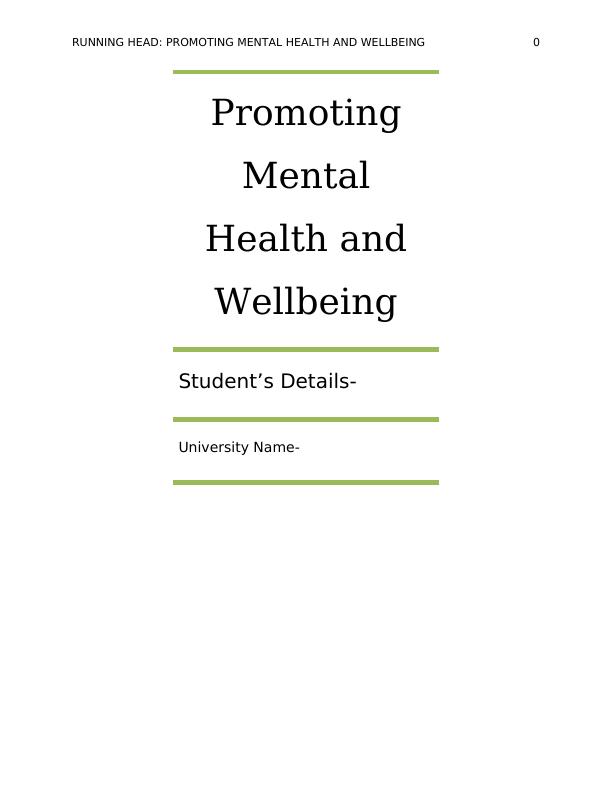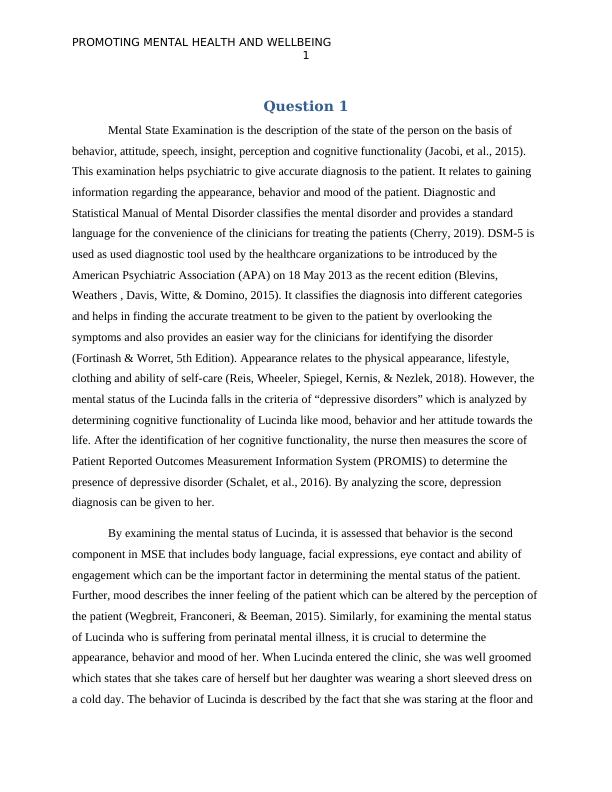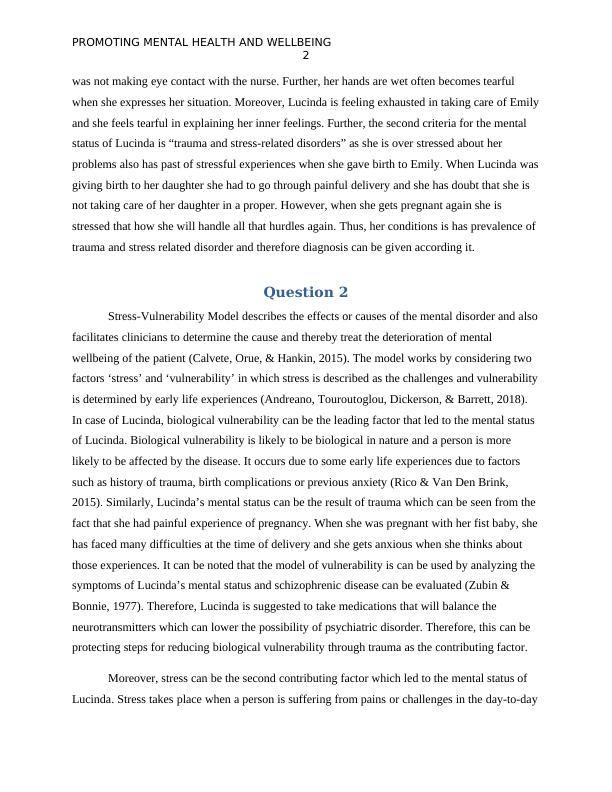Promoting Mental Health and Wellbeing
Added on 2022-12-27
8 Pages2767 Words1 Views
RUNNING HEAD: PROMOTING MENTAL HEALTH AND WELLBEING 0
Promoting
Mental
Health and
Wellbeing
Student’s Details-
University Name-
Promoting
Mental
Health and
Wellbeing
Student’s Details-
University Name-

PROMOTING MENTAL HEALTH AND WELLBEING
1
Question 1
Mental State Examination is the description of the state of the person on the basis of
behavior, attitude, speech, insight, perception and cognitive functionality (Jacobi, et al., 2015).
This examination helps psychiatric to give accurate diagnosis to the patient. It relates to gaining
information regarding the appearance, behavior and mood of the patient. Diagnostic and
Statistical Manual of Mental Disorder classifies the mental disorder and provides a standard
language for the convenience of the clinicians for treating the patients (Cherry, 2019). DSM-5 is
used as used diagnostic tool used by the healthcare organizations to be introduced by the
American Psychiatric Association (APA) on 18 May 2013 as the recent edition (Blevins,
Weathers , Davis, Witte, & Domino, 2015). It classifies the diagnosis into different categories
and helps in finding the accurate treatment to be given to the patient by overlooking the
symptoms and also provides an easier way for the clinicians for identifying the disorder
(Fortinash & Worret, 5th Edition). Appearance relates to the physical appearance, lifestyle,
clothing and ability of self-care (Reis, Wheeler, Spiegel, Kernis, & Nezlek, 2018). However, the
mental status of the Lucinda falls in the criteria of “depressive disorders” which is analyzed by
determining cognitive functionality of Lucinda like mood, behavior and her attitude towards the
life. After the identification of her cognitive functionality, the nurse then measures the score of
Patient Reported Outcomes Measurement Information System (PROMIS) to determine the
presence of depressive disorder (Schalet, et al., 2016). By analyzing the score, depression
diagnosis can be given to her.
By examining the mental status of Lucinda, it is assessed that behavior is the second
component in MSE that includes body language, facial expressions, eye contact and ability of
engagement which can be the important factor in determining the mental status of the patient.
Further, mood describes the inner feeling of the patient which can be altered by the perception of
the patient (Wegbreit, Franconeri, & Beeman, 2015). Similarly, for examining the mental status
of Lucinda who is suffering from perinatal mental illness, it is crucial to determine the
appearance, behavior and mood of her. When Lucinda entered the clinic, she was well groomed
which states that she takes care of herself but her daughter was wearing a short sleeved dress on
a cold day. The behavior of Lucinda is described by the fact that she was staring at the floor and
1
Question 1
Mental State Examination is the description of the state of the person on the basis of
behavior, attitude, speech, insight, perception and cognitive functionality (Jacobi, et al., 2015).
This examination helps psychiatric to give accurate diagnosis to the patient. It relates to gaining
information regarding the appearance, behavior and mood of the patient. Diagnostic and
Statistical Manual of Mental Disorder classifies the mental disorder and provides a standard
language for the convenience of the clinicians for treating the patients (Cherry, 2019). DSM-5 is
used as used diagnostic tool used by the healthcare organizations to be introduced by the
American Psychiatric Association (APA) on 18 May 2013 as the recent edition (Blevins,
Weathers , Davis, Witte, & Domino, 2015). It classifies the diagnosis into different categories
and helps in finding the accurate treatment to be given to the patient by overlooking the
symptoms and also provides an easier way for the clinicians for identifying the disorder
(Fortinash & Worret, 5th Edition). Appearance relates to the physical appearance, lifestyle,
clothing and ability of self-care (Reis, Wheeler, Spiegel, Kernis, & Nezlek, 2018). However, the
mental status of the Lucinda falls in the criteria of “depressive disorders” which is analyzed by
determining cognitive functionality of Lucinda like mood, behavior and her attitude towards the
life. After the identification of her cognitive functionality, the nurse then measures the score of
Patient Reported Outcomes Measurement Information System (PROMIS) to determine the
presence of depressive disorder (Schalet, et al., 2016). By analyzing the score, depression
diagnosis can be given to her.
By examining the mental status of Lucinda, it is assessed that behavior is the second
component in MSE that includes body language, facial expressions, eye contact and ability of
engagement which can be the important factor in determining the mental status of the patient.
Further, mood describes the inner feeling of the patient which can be altered by the perception of
the patient (Wegbreit, Franconeri, & Beeman, 2015). Similarly, for examining the mental status
of Lucinda who is suffering from perinatal mental illness, it is crucial to determine the
appearance, behavior and mood of her. When Lucinda entered the clinic, she was well groomed
which states that she takes care of herself but her daughter was wearing a short sleeved dress on
a cold day. The behavior of Lucinda is described by the fact that she was staring at the floor and

PROMOTING MENTAL HEALTH AND WELLBEING
2
was not making eye contact with the nurse. Further, her hands are wet often becomes tearful
when she expresses her situation. Moreover, Lucinda is feeling exhausted in taking care of Emily
and she feels tearful in explaining her inner feelings. Further, the second criteria for the mental
status of Lucinda is “trauma and stress-related disorders” as she is over stressed about her
problems also has past of stressful experiences when she gave birth to Emily. When Lucinda was
giving birth to her daughter she had to go through painful delivery and she has doubt that she is
not taking care of her daughter in a proper. However, when she gets pregnant again she is
stressed that how she will handle all that hurdles again. Thus, her conditions is has prevalence of
trauma and stress related disorder and therefore diagnosis can be given according it.
Question 2
Stress-Vulnerability Model describes the effects or causes of the mental disorder and also
facilitates clinicians to determine the cause and thereby treat the deterioration of mental
wellbeing of the patient (Calvete, Orue, & Hankin, 2015). The model works by considering two
factors ‘stress’ and ‘vulnerability’ in which stress is described as the challenges and vulnerability
is determined by early life experiences (Andreano, Touroutoglou, Dickerson, & Barrett, 2018).
In case of Lucinda, biological vulnerability can be the leading factor that led to the mental status
of Lucinda. Biological vulnerability is likely to be biological in nature and a person is more
likely to be affected by the disease. It occurs due to some early life experiences due to factors
such as history of trauma, birth complications or previous anxiety (Rico & Van Den Brink,
2015). Similarly, Lucinda’s mental status can be the result of trauma which can be seen from the
fact that she had painful experience of pregnancy. When she was pregnant with her fist baby, she
has faced many difficulties at the time of delivery and she gets anxious when she thinks about
those experiences. It can be noted that the model of vulnerability is can be used by analyzing the
symptoms of Lucinda’s mental status and schizophrenic disease can be evaluated (Zubin &
Bonnie, 1977). Therefore, Lucinda is suggested to take medications that will balance the
neurotransmitters which can lower the possibility of psychiatric disorder. Therefore, this can be
protecting steps for reducing biological vulnerability through trauma as the contributing factor.
Moreover, stress can be the second contributing factor which led to the mental status of
Lucinda. Stress takes place when a person is suffering from pains or challenges in the day-to-day
2
was not making eye contact with the nurse. Further, her hands are wet often becomes tearful
when she expresses her situation. Moreover, Lucinda is feeling exhausted in taking care of Emily
and she feels tearful in explaining her inner feelings. Further, the second criteria for the mental
status of Lucinda is “trauma and stress-related disorders” as she is over stressed about her
problems also has past of stressful experiences when she gave birth to Emily. When Lucinda was
giving birth to her daughter she had to go through painful delivery and she has doubt that she is
not taking care of her daughter in a proper. However, when she gets pregnant again she is
stressed that how she will handle all that hurdles again. Thus, her conditions is has prevalence of
trauma and stress related disorder and therefore diagnosis can be given according it.
Question 2
Stress-Vulnerability Model describes the effects or causes of the mental disorder and also
facilitates clinicians to determine the cause and thereby treat the deterioration of mental
wellbeing of the patient (Calvete, Orue, & Hankin, 2015). The model works by considering two
factors ‘stress’ and ‘vulnerability’ in which stress is described as the challenges and vulnerability
is determined by early life experiences (Andreano, Touroutoglou, Dickerson, & Barrett, 2018).
In case of Lucinda, biological vulnerability can be the leading factor that led to the mental status
of Lucinda. Biological vulnerability is likely to be biological in nature and a person is more
likely to be affected by the disease. It occurs due to some early life experiences due to factors
such as history of trauma, birth complications or previous anxiety (Rico & Van Den Brink,
2015). Similarly, Lucinda’s mental status can be the result of trauma which can be seen from the
fact that she had painful experience of pregnancy. When she was pregnant with her fist baby, she
has faced many difficulties at the time of delivery and she gets anxious when she thinks about
those experiences. It can be noted that the model of vulnerability is can be used by analyzing the
symptoms of Lucinda’s mental status and schizophrenic disease can be evaluated (Zubin &
Bonnie, 1977). Therefore, Lucinda is suggested to take medications that will balance the
neurotransmitters which can lower the possibility of psychiatric disorder. Therefore, this can be
protecting steps for reducing biological vulnerability through trauma as the contributing factor.
Moreover, stress can be the second contributing factor which led to the mental status of
Lucinda. Stress takes place when a person is suffering from pains or challenges in the day-to-day

End of preview
Want to access all the pages? Upload your documents or become a member.
Related Documents
Promoting Mental Health | Assignmentlg...
|9
|2105
|21
Mental Health: Assessment and Recoverylg...
|7
|2139
|396
Mental Health Carelg...
|10
|2407
|53
Mental Health Assessment: Case Study of Lucinda Okirolg...
|9
|2526
|4
Mental Illness and its Impact on Perinatal Mental Health: A Case Studylg...
|9
|2399
|108
Examining Mental Health: Components and Principleslg...
|9
|2282
|72
